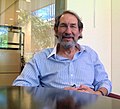Ficheru:Geoffrey West.jpg

Tamañu d'esta previsualización: 661 × 600 pixels. Otres resoluciones: 264 × 240 pixels | 529 × 480 pixels | 846 × 768 pixels | 1128 × 1024 pixels | 1322 × 1200 pixels.
Ficheru orixinal (1322 × 1200 píxels, tamañu de ficheru: 559 kB, triba MIME: image/jpeg)
Historial del ficheru
Calca nuna fecha/hora pa ver el ficheru como taba daquella.
| Data/Hora | Miniatura | Dimensiones | Usuariu | Comentariu | |
|---|---|---|---|---|---|
| actual | 09:53 30 xnt 2007 |  | 1322 × 1200 (559 kB) | FlickreviewR | Replacing image by its original image from FlickR |
| 03:44 30 xnt 2007 |  | 1024 × 930 (547 kB) | PDH | {{Information |Description= "As animals get bigger, from tiny shrew to huge blue whale, pulse rates slow down and life spans stretch out longer, conspiring so that the number of heartbeats during an average stay on Earth tends to be roughly the same, arou |
Usu del ficheru
Nun hai páxines qu'usen esti ficheru.
Usu global del ficheru
Estes otres wikis usen esti ficheru:
- Usu en ar.wikipedia.org
- Usu en azb.wikipedia.org
- Usu en de.wikipedia.org
- Usu en en.wikipedia.org
- Usu en en.wikiquote.org
- Usu en fa.wikipedia.org
- Usu en fa.wikiquote.org
- Usu en fr.wikipedia.org
- Usu en gd.wikipedia.org
- Usu en hy.wikipedia.org
- Usu en it.wikipedia.org
- Usu en ja.wikipedia.org
- Usu en ko.wikipedia.org
- Usu en nl.wikipedia.org
- Usu en pa.wikipedia.org
- Usu en pl.wikipedia.org
- Usu en pnb.wikipedia.org
- Usu en sr.wikipedia.org
- Usu en sv.wikipedia.org
- Usu en vi.wikipedia.org
- Usu en zh.wikipedia.org
